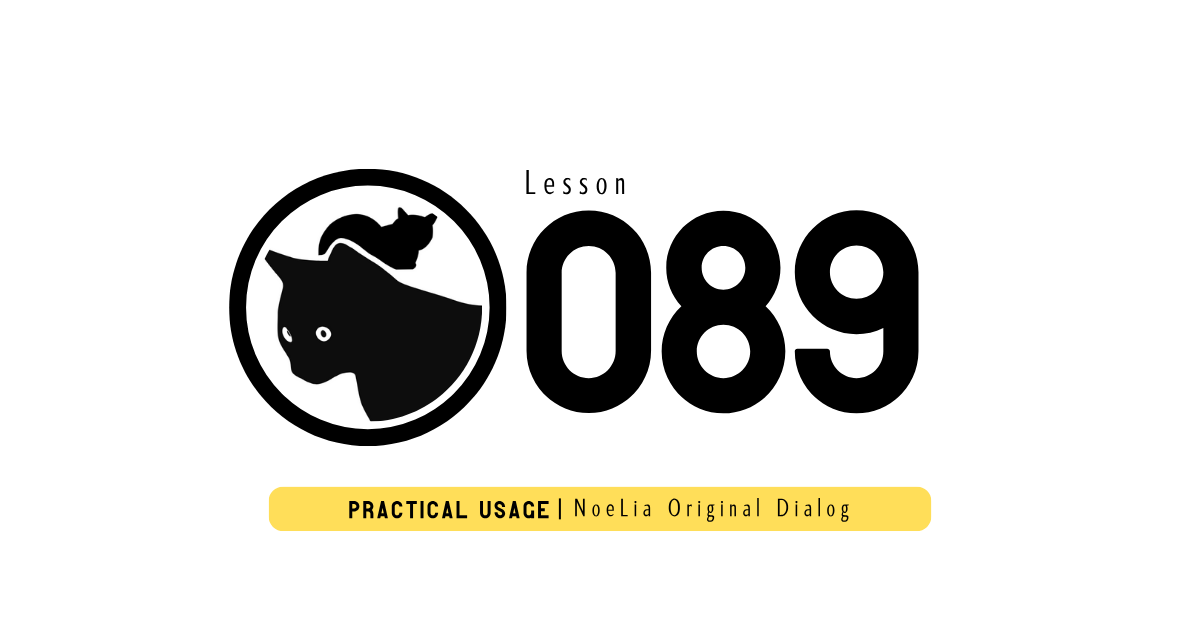ノエリアオリジナルの「Listening Challenge」も掲載中!
昨年度は英作文の出題が3問あったため、ノエリアオリジナル会話例を3本紹介していましたが、今年度は1問にギュッと凝縮!そのぶん、語彙・表現の工夫を詰め込んだ「Listening Challenge」のノエリアオリジナル版をお届けします!Let’s give it a try!
👇こちらはLesson 089のコーナー別リンクです
ラジオ英会話 Lesson089|入手を表す動詞① ー take の基本的な意味:「選択」ほか
GRAMMAR AND VOCABULARY L089|NoeLia Original Dialog
GRASP THE CONCEPT L089|入手を表す動詞① ー take の基本的な意味:「選択」ほか|NoeLia Original Dialog
PRACTICAL USAGE L089|NoeLia Original Dialog
PRACTICAL USAGE(ノエリア オリジナル スクリプト)
下記はノエリアオリジナルの解答例です。
ラジオ英会話の『PRACTICAL USAGE』コーナーの状況を参考に、そのフレーズを自然に使ったオリジナル会話例も掲載しています!模範解答とは異なる表現を学びつつ、音声を使ってディクテーションや多聴多読に取り組むことで、英語をさらに身近に楽しく学びましょう。実際の会話で活用できる内容が盛り込まれているので、スピーキングの向上や復習にもぜひご活用ください!
問題:公園への行き方は2つあります。バスに乗るなら北口に着きます。電車なら南口に着きます。どちらか希望はありますか?
引用:「NHKラジオ英会話 2025年8月号」 – 講師:大西泰斗(東洋学園大学教授) – (NHK出版:2025年)
We have two options for going to the park. If we take the bus, it’ll take us to the north entrance. If we take the train, it’ll take us to the south entrance. Do you have a preference?
There are two ways to get to the park. Taking the bus will drop us off at the north entrance, and taking the train will bring us to the south entrance. Which would you prefer?
日本語訳: 公園まで行く方法は2通りあるよ。バスなら北口で降ろしてくれるし、電車なら南口まで連れてってくれる。どっちがいい?
解説: 模範解答は道案内として落ち着いた説明になっており、丁寧なガイドや書き言葉のシーンにも合います。ノエリアの解答例は会話の流れが口語的で、身近な友人や同僚とのやりとり、ラフな場面にしっくりきます。どちらも行き方の違いを明確に伝えられますが、シーンの雰囲気や距離感に合わせて使い分けできます。
We have two options for going to the park. If we take the bus, it’ll take us to the north entrance. If we take the train, it’ll take us to the south entrance. Do you have a preference?
- options: 選択肢(「どちらか選べる」という意味。決まった中から選ぶイメージで使う名詞)
- for going to the park: 公園に行くために(to goよりも、「行くこと自体」を目的にするやや堅い言い方)
- take the bus / take the train: バスに乗る/電車に乗る(「take」は移動手段で定番。go byよりも「乗る」という具体的な動作が強い)
- it’ll take us to~: ~に連れていってくれる(乗り物などが目的地へ「到達させる」意味。交通機関でよく使う表現)
- Do you have a preference?: どちらか希望はありますか?(preferenceは「好み」「希望」。丁寧に意見や希望を聞く定番表現)
There are two ways to get to the park. Taking the bus will drop us off at the north entrance, and taking the train will bring us to the south entrance. Which would you prefer?
- ways: 方法/道(「ways to get to~」で「〜へ行く手段・道」。“options”よりもカジュアルで、複数の方法を柔らかく提示)
- get to: ~に到着する(go toより「たどり着く」のニュアンスが強い。「着くまでの道のり」も意識する表現)
- Taking the bus: バスに乗ること(動名詞で「バスに乗る場合」の意味。if we take the busよりも文が短く、会話的な雰囲気)
- drop us off at~: ~で降ろしてくれる(drop offは「降ろす」「下ろす」。“take us to”との違いは「降ろしてくれる」動作の細やかさ。車・バスなど、実際の移動でよく使う口語)
- bring us to~: ~に連れてきてくれる(bringは「自分のいる場所へ持ってくる・連れてくる」ニュアンス。「take」より相手に寄り添った言い方。到着する側の視点が強い)
- Which would you prefer?: どっちがいい?(どちらか選んでほしいときのカジュアルで優しい聞き方。Do you have a preference?よりもラフな響き)
Listening Challenge|ノエリアオリジナル問題
ラジオ英会話の金曜恒例「リスニングチャレンジ」を、ノエリア版オリジナルダイアログでお届けします!音声を用意したので、本編と共に、ぜひチャレンジしてみてくださいね!
クリックすると問題が出ます。
Here’s the question.
Which of the following is true?
A. Ryan prefers the bus because it’s faster.
B. The train provides a nicer view than the bus.
C. Both the bus and the train take the same amount of time.
Let’s listen.
Original Dialog|ノエリア会話スクリプト
ライアンと友人のソフィーが休日に一緒に出かけています。初めて訪れるエリアを散策しながら、公園までの行き方を相談しているようですね。
Ryan: So, this is your first time in this part of the city, right?
Sophie: Yeah, I’ve only ever seen it from the train before.
Ryan: The park here’s actually kind of far to walk, so we’ll need to take either the bus or the train to get there.
Sophie: Got it. Which way is better?
Ryan: There are two ways to get to the park. Taking the bus will drop us off at the north entrance, and taking the train will bring us to the south entrance. Which would you prefer?
Sophie: Is there any difference?
Ryan: The bus is a bit faster, but the train’s more scenic.
Sophie: Let’s take the train then! I want to see the view.
ライアン: ここ来るの初めてだよね?
ソフィー: うん、今まで電車から見ただけで降りたことなかったんだ。
ライアン: ここの公園、実は歩くにはちょっと遠いから、バスか電車で行く必要があるんだよね。
ソフィー: 了解。どっちのルートがいい?
ライアン: 公園への行き方は2つあって、バスだと北口に着くし、電車だと南口に着くよ。どっちがいい?
ソフィー: 何か違いある?
ライアン: バスの方がちょっと早いけど、電車は景色がいいよ。
ソフィー: じゃあ電車にしよう!景色見たいし。
- part of the city: このあたり/この地域(“part”は「一部」だが、cityと組み合わせると「この界隈」や「このエリア」という日常の範囲を自然に表せる)
- more scenic: 景色がいい(“scenic”は「景色が美しい」。moreをつけて比較)
Answer & 解説|ノエリアオリジナル問題の答え
Here’s the question.
Which of the following is true?
A. Ryan prefers the bus because it’s faster.
B. The train provides a nicer view than the bus.
C. Both the bus and the train take the same amount of time.
クリックすると答えが出ます。
B. The train provides a nicer view than the bus.
A. Ryan prefers the bus because it’s faster.(ライアンはバスの方が速いからバスを好む)
この選択肢は、”The bus is a bit faster” という発言に着目したものですが、Ryanが「バスを好む(prefers)」とは会話中で明言していません。バスが速いという情報は出ていますが、好みについては言及がなく、正解とはなりません。
B. The train provides a nicer view than the bus.(電車の方がバスより眺めが良い)
この選択肢は、”the train’s more scenic” という発言を言い換えたものです。”scenic” は「景色が良い」という意味の形容詞です。ダイアログではRyanが「電車の方が景色が良い」と説明しており、この選択肢が正解となります。
C. Both the bus and the train take the same amount of time.(バスも電車も所要時間は同じ)
この選択肢は、”The bus is a bit faster” という事実と矛盾しています。バスの方が少し速いことが会話の中で示されているため、この選択肢は不正解です。
キーワードの正確な聞き取り
- the bus is a bit faster: バスの方が少し速いことを示す発言で、選択肢AやCの正否を見極めるポイントになります。
- the train’s more scenic: “scenic”(景色が良い)がキーワードで、選択肢Bが正しいと判断するために不可欠です。
- Which would you prefer?: 好みを尋ねる発言ですが、Ryan本人の好みは会話に出てきていないので、選択肢Aの引っかけに注意が必要です。
会話のテーマを理解すること
このダイアログでは、RyanがSophieに公園までの行き方を説明しながら、それぞれのルートの特徴(速さと景色の良さ)について案内しています。好みや選択を尋ねるやりとりの中で、事実情報として「電車は景色が良い(the train’s more scenic)」としっかり説明されているため、この情報が正答の根拠となります。また、直接的な好みの表現がなくても、客観的な事実の聞き取りがリスニングでは重要です。


